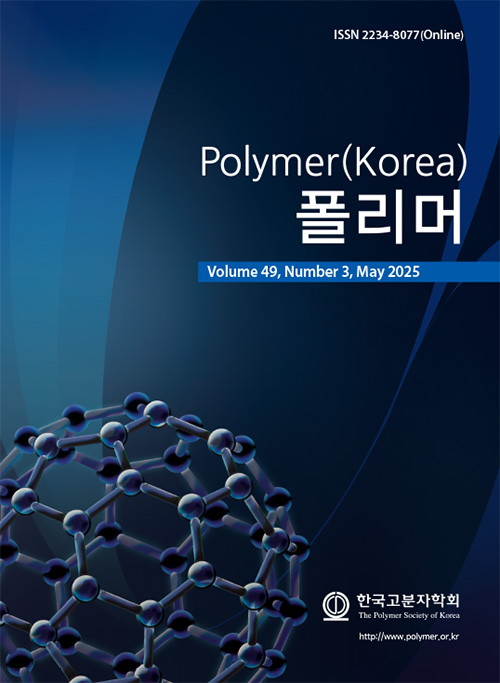- Mechanical Properties and Crystallization Behavior of Surface-Treated Waste Phenol Resin-based Polyamide 6 Composites
In Gyu Choi*, **, Tae Min Lee*, **, Se Jun Yang*, **, Seung-Ju Oh*, **, Jin Woo Bae*, **,†
 , and Byeong Uk Nam*,†
, and Byeong Uk Nam*,† 
*Department of Chemical and Biological Engineering, Korea University of Technology and Education, 1600, Chunjeol-ro, Byeongcheon-myeon, Dongnam-gu, Cheonan-si, Chungcheongnam-do, 31253, Korea
**Future Convergence Engineering, Korea University of Technology and Education 1600, Chunjeol-ro, Byeongcheon-myeon, Dongnam-gu, Cheonan-si, Chungcheongnam-do, 31253, Korea- 표면 처리된 폐페놀 레진기반 Polyamide 6 복합체의 기계적 특성과 결정화 거동
최인규*, ** · 이태민*, ** · 양세준*, ** · 오승주*, ** · 배진우*, **,†
 · 남병욱*,†
· 남병욱*,† 
*한국기술교육대학교 화학생명공학전공, **한국기술교육대학교 미래융합공학전공
Reproduction, stored in a retrieval system, or transmitted in any form of any part of this publication is permitted only by written permission from the Polymer Society of Korea.
Phenolic resin, a thermosetting resin, possesses excellent mechanical properties. However, due to its thermosetting nature, it is difficult to recycle after use, resulting in 15-20% of the total production being discarded. In this study, thermosetting waste phenolic resin with excellent mechanical properties was physically pulverized and recycled as a filler material for polyamide 6 (PA6) composites. First, to improve the surface adhesion between the pulverized waste phenolic resin and PA6, the surface was treated with (3-glycidyloxypropyl) trimethoxysilane, an epoxy-functional silane coupling agent. The composite was prepared by PA6 into the surface-treated recycled phenolic resin using a twin-screw extruder. Unlike composites made with untreated recycled phenolic resin, the PA6/phenolic resin composite using silane-treated recycled phenolic resin exhibited enhanced tensile strength and flexural modulus as the content increased. Additionally, the decrease in impact strength was relatively moderate. To investigate the cause of these improved mechanical properties, composites were analyzed using the infrared spectra and non-isothermal crystallization behavior under various cooling rates. The crystallinity and crystallization rate were evaluated using the modified Avrami model. The results confirmed that the silane-treated recycled phenolic resin improved the mechanical properties by promoting anisotropic crystallization growth, achieving high crystallinity, and enhancing crystallization rates due to its chemical interactions with PA6.
페놀 레진은 열경화성 수지로서 우수한 기계적 물성을 가지고 있다. 하지만 열경화 특성으로 인해 사용 후 재활용이 어렵고, 전체 생산량의 15-20%가 폐기되고 있다. 본 연구에서는 기계적 특성이 우수한 열경화성 폐페놀 레진을 물리적으로 분쇄하고 이를 폴리아미드 6(PA6) 복합체의 필러로 재활용하고자 하였다. 먼저, 분쇄시킨 폐페놀 레진을 PA6와 표면 접착력을 향상시키기 위해 에폭시 기능기가 있는 실란 커플링제인 (3-glycidyloxypropyl) trimethoxysilane으로 표면 처리하였다. 이렇게 표면 처리한 폐페놀 레진에 PA6를 도입하여 twin screw extruder에서 복합체를 제조하였다. 실란 처리한 폐페놀이 도입된 PA6/폐페놀 복합체는 실란 처리하지 않은 폐페놀이 도입된 PA6/폐페놀 복합체와 다르게, 함량이 높아질수록 인장강도와 굴곡탄성률이 높아지면서, 충격강도의 감소는 상대적으로 덜 낮아졌다. 이렇게 실란 처리한 폐페놀이 도입된 PA6/폐페놀 복합체의 향상된 기계적 물성의 원인을 확인하기 위해서 적외선 분광분석법과 다양한 냉각 속도 조건 하에서 비등온 결정화 거동을 분석하고 수정된 Avrami 모델을 적용하여 결정화도와 결정화 속도 등을 확인하였다. 이를 통해서 실란 처리한 폐페놀 레진이 PA6와의 화학적 상호작용으로 비등방성 결정화 성장과정과 높은 결정화도와 빠른 결정화 속도를 구현하여 기계적 물성에 영향을 미쳤다.
Keywords: recycle, phenol composite, (3-glycidyloxypropyl) trimethoxysilane, polyamide 6, modified Avrami model, crystallinity.
- Polymer(Korea) 폴리머
- Frequency : Bimonthly(odd)
ISSN 2234-8077(Online)
Abbr. Polym. Korea - 2024 Impact Factor : 0.6
- Indexed in SCIE
 This Article
This Article
-
2025; 49(3): 306-316
Published online May 25, 2025
- 10.7317/pk.2025.49.3.306
- Received on Nov 5, 2024
- Revised on Dec 20, 2024
- Accepted on Dec 23, 2024
 Correspondence to
Correspondence to
- Jin Woo Bae*, ** , and Byeong Uk Nam*
-
*Department of Chemical and Biological Engineering, Korea University of Technology and Education, 1600, Chunjeol-ro, Byeongcheon-myeon, Dongnam-gu, Cheonan-si, Chungcheongnam-do, 31253, Korea
**Future Convergence Engineering, Korea University of Technology and Education 1600, Chunjeol-ro, Byeongcheon-myeon, Dongnam-gu, Cheonan-si, Chungcheongnam-do, 31253, Korea - E-mail: jwbae@koreatech.ac.kr, bunam@koreatech.ac.kr








 Copyright(c) The Polymer Society of Korea. All right reserved.
Copyright(c) The Polymer Society of Korea. All right reserved.